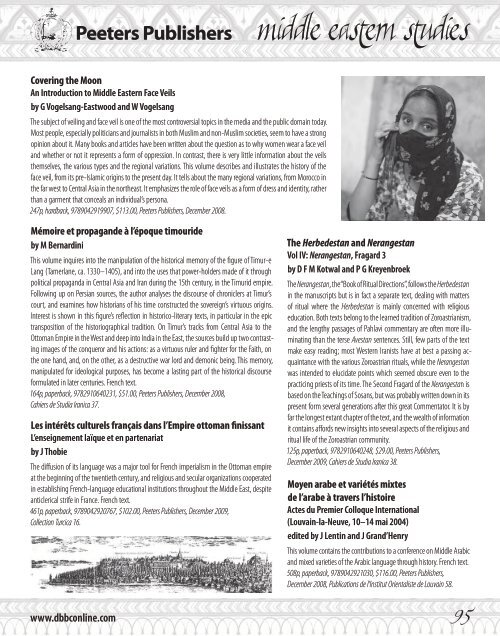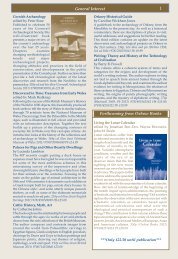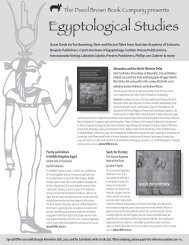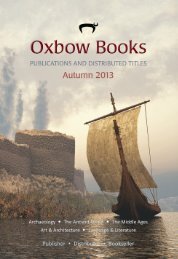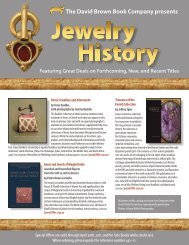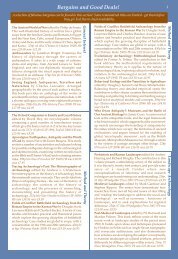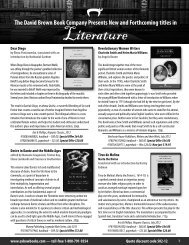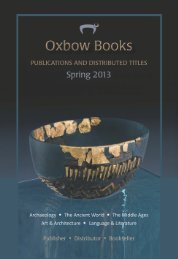New Distributed Titles Fall 2009 - Oxbow Books
New Distributed Titles Fall 2009 - Oxbow Books
New Distributed Titles Fall 2009 - Oxbow Books
You also want an ePaper? Increase the reach of your titles
YUMPU automatically turns print PDFs into web optimized ePapers that Google loves.
Peeters Publishers<br />
Covering the Moon<br />
An Introduction to Middle Eastern Face Veils<br />
by G Vogelsang-Eastwood and W Vogelsang<br />
The subject of veiling and face veil is one of the most controversial topics in the media and the public domain today.<br />
Most people, especially politicians and journalists in both Muslim and non-Muslim societies, seem to have a strong<br />
opinion about it. Many books and articles have been written about the question as to why women wear a face veil<br />
and whether or not it represents a form of oppression. In contrast, there is very little information about the veils<br />
themselves, the various types and the regional variations. This volume describes and illustrates the history of the<br />
face veil, from its pre-Islamic origins to the present day. It tells about the many regional variations, from Morocco in<br />
the far west to Central Asia in the northeast. It emphasizes the role of face veils as a form of dress and identity, rather<br />
than a garment that conceals an individual’s persona.<br />
247p, hardback, 9789042919907, $113.00, Peeters Publishers, December 2008.<br />
Mémoire et propagande à l’époque timouride<br />
by M Bernardini<br />
This volume inquires into the manipulation of the historical memory of the figure of Timur-e<br />
Lang (Tamerlane, ca. 1330–1405), and into the uses that power-holders made of it through<br />
political propaganda in Central Asia and Iran during the 15th century, in the Timurid empire.<br />
Following up on Persian sources, the author analyses the discourse of chroniclers at Timur’s<br />
court, and examines how historians of his time constructed the sovereign’s virtuous origins.<br />
Interest is shown in this figure’s reflection in historico-literary texts, in particular in the epic<br />
transposition of the historiographical tradition. On Timur’s tracks from Central Asia to the<br />
Ottoman Empire in the West and deep into India in the East, the sources build up two contrasting<br />
images of the conqueror and his actions: as a virtuous ruler and fighter for the Faith, on<br />
the one hand, and, on the other, as a destructive war lord and demonic being. This memory,<br />
manipulated for ideological purposes, has become a lasting part of the historical discourse<br />
formulated in later centuries. French text.<br />
164p, paperback, 9782910640231, $51.00, Peeters Publishers, December 2008,<br />
Cahiers de Studia Iranica 37.<br />
Les intérêts culturels français dans l’Empire ottoman finissant<br />
L’enseignement laïque et en partenariat<br />
by J Thobie<br />
The diffusion of its language was a major tool for French imperialism in the Ottoman empire<br />
at the beginning of the twentieth century, and religious and secular organizations cooperated<br />
in establishing French-language educational institutions throughout the Middle East, despite<br />
anticlerical strife in France. French text.<br />
461p, paperback, 9789042920767, $102.00, Peeters Publishers, December <strong>2009</strong>,<br />
Collection Turcica 16.<br />
middle eastern studies<br />
The Herbedestan and Nerangestan<br />
Vol IV: Nerangestan, Fragard 3<br />
by D F M Kotwal and P G Kreyenbroek<br />
The Nerangestan, the “Book of Ritual Directions”, follows the Herbedestan<br />
in the manuscripts but is in fact a separate text, dealing with matters<br />
of ritual where the Herbedestan is mainly concerned with religious<br />
education. Both texts belong to the learned tradition of Zoroastrianism,<br />
and the lengthy passages of Pahlavi commentary are often more illuminating<br />
than the terse Avestan sentences. Still, few parts of the text<br />
make easy reading; most Western Iranists have at best a passing acquaintance<br />
with the various Zoroastrian rituals, while the Nerangestan<br />
was intended to elucidate points which seemed obscure even to the<br />
practicing priests of its time. The Second Fragard of the Nerangestan is<br />
based on the Teachings of Sosans, but was probably written down in its<br />
present form several generations after this great Commentator. It is by<br />
far the longest extant chapter of the text, and the wealth of information<br />
it contains affords new insights into several aspects of the religious and<br />
ritual life of the Zoroastrian community.<br />
125p, paperback, 9782910640248, $29.00, Peeters Publishers,<br />
December <strong>2009</strong>, Cahiers de Studia Iranica 38.<br />
Moyen arabe et variétés mixtes<br />
de l’arabe à travers l’histoire<br />
Actes du Premier Colloque International<br />
(Louvain-la-Neuve, 10–14 mai 2004)<br />
edited by J Lentin and J Grand’Henry<br />
This volume contains the contributions to a conference on Middle Arabic<br />
and mixed varieties of the Arabic language through history. French text.<br />
508p, paperback, 9789042921030, $116.00, Peeters Publishers,<br />
December 2008, Publications de l’Institut Orientaliste de Louvain 58.<br />
www.dbbconline.com 95


